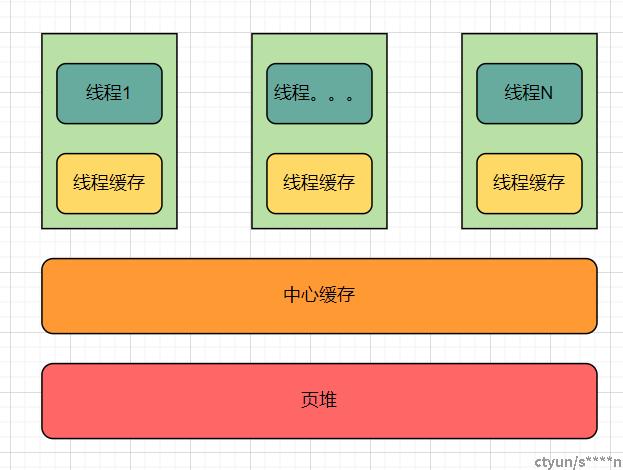golang借鉴TCMalloc内存分配机制,实现了自己基于多级缓存的告诉内存分配机制。
分级分配
对象分级
golang内存分配器,根据申请分给的大小,选择不同的处理逻辑,运行时根据对象的大小将对象分成微对象、小对象和大对象三种。
| 类别 | 大小 |
| 微对象 | (0,16B) |
| 小对象 | [16B,32KB] |
| 大对象 | (32KB, +∞) |
缓存分级
golang会讲内存分成不同的级别进行管理,包括线程缓存,中心缓存,页堆三级缓存
线程缓存:属于每一个独立的线程,为一个线程独立拥有,使用过程中不需要加锁
中心缓存:当线程缓存不能满足需求时,runtime会使用中心缓存,中心缓存为全局所有,使用需要加锁;
页堆缓存:当中心缓存不足或遇到32KB以上的大对象时,会选择在页堆分配内存;

内存管理组件
golang的内存分配器包含内存管理单元、线程缓存、中心缓存、页堆;
内存管理单元
内存管理单元是Golang内存管理的基本单元,通过内部next和prev两个指针将内存管理单元构成一个双向链表。
数据结构
next *mspan // next span in list, or nil if none
prev *mspan // previous span in list, or nil if none
npages uintptr // number of pages in span
allocBits *gcBits
gcmarkBits *gcBits
。。。
// sweep generation:
// if sweepgen == h->sweepgen - 2, the span needs sweeping
// if sweepgen == h->sweepgen - 1, the span is currently being swept
// if sweepgen == h->sweepgen, the span is swept and ready to use
// if sweepgen == h->sweepgen + 1, the span was cached before sweep began and is still cached, and needs sweeping
// if sweepgen == h->sweepgen + 3, the span was swept and then cached and is still cached
// h->sweepgen is incremented by 2 after every GC
。。。线程缓存
线程缓存是线程私有的缓存,会与线程上的处理器一一绑定,主要用来缓存用户程序申请的微小对象。
每一个线程缓存都持有68*2个runtime.mspan,这些内存管理单元都保存在线程缓存的alloc字段;线程缓存初始化时是不分配runtime.mspn的,当用户程序申请内存时,才会从上一级组件获取新的runtime.mspan以满足内存分配的需求。
数据结构
type mcache struct {
nextSample uintptr // trigger heap sample after allocating this many bytes
scanAlloc uintptr // bytes of scannable heap allocated
tiny uintptr
tinyoffset uintptr
tinyAllocs uintptr
alloc [numSpanClasses]*mspan // spans to allocate from, indexed by spanClass
flushGen uint32
}
中心缓存
中心缓存和线程缓存不同,中心缓存是全局可见的,所以访问中心缓存的内存管理的单元需要使用互斥锁;每个中心缓存都会管理一个具体跨度类别的内存管理单元(golang根据对象的大小,将对象分为不同的跨度类别),它会持有2个不同的runtime.spanSet,分别存储包含空闲对象和不包含空闲对象的内存管理单元。
数据结构
type mcentral struct {
spanclass spanClass
partial [2]spanSet // list of spans with a free object
full [2]spanSet // list of spans with no free objects
}页堆
页堆中包含2个中心缓存,一个是需要scan拥有68个跨度的中心缓存,另外一个是不需要scan拥有68个跨度的中心缓存。
数据结构
type mheap struct {
lock mutex
pages pageAlloc // page allocation data structure
sweepgen uint32 // sweep generation, see comment in mspan; written during STW
sweepdone uint32 // all spans are swept
sweepers uint32 // number of active sweepone calls
allspans []*mspan // all spans out there
pagesInUse uint64 // pages of spans in stats mSpanInUse; updated atomically
pagesSwept uint64 // pages swept this cycle; updated atomically
pagesSweptBasis uint64 // pagesSwept to use as the origin of the sweep ratio; updated atomically
sweepHeapLiveBasis uint64 // value of heap_live to use as the origin of sweep ratio; written with lock, read without
sweepPagesPerByte float64 // proportional sweep ratio; written with lock, read without
arenas [1 << arenaL1Bits]*[1 << arenaL2Bits]*heapArena
heapArenaAlloc linearAlloc
allArenas []arenaIdx
// sweepArenas is a snapshot of allArenas taken at the
// beginning of the sweep cycle. This can be read safely by
// simply blocking GC (by disabling preemption).
sweepArenas []arenaIdx
// markArenas is a snapshot of allArenas taken at the beginning
// of the mark cycle. Because allArenas is append-only, neither
// this slice nor its contents will change during the mark, so
// it can be read safely.
markArenas []arenaIdx
// curArena is the arena that the heap is currently growing
// into. This should always be physPageSize-aligned.
curArena struct {
base, end uintptr
}
central [numSpanClasses]struct {
mcentral mcentral
pad [cpu.CacheLinePadSize - unsafe.Sizeof(mcentral{})%cpu.CacheLinePadSize]byte
}
}